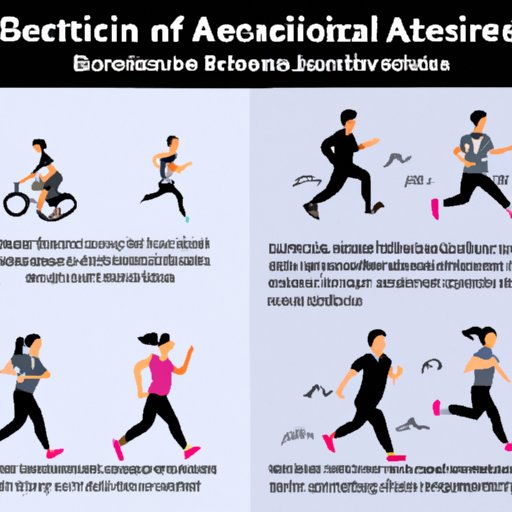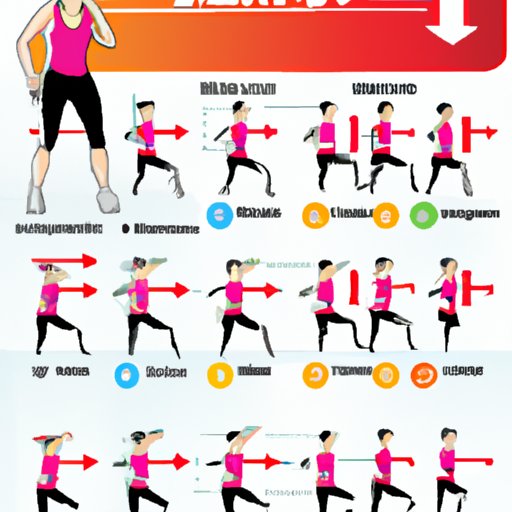Introduction
Aerobic fitness is an important component of overall health and wellbeing. It involves engaging in regular physical activities that increase your heart rate and breathing, and ultimately improve your cardiovascular endurance. In this article, we will explore what aerobic fitness is, its benefits, and how to get started with aerobic exercise.

The Science Behind Aerobic Fitness
Aerobic exercise is any type of physical activity that increases the demand for oxygen. During aerobic exercise, your body’s cells use oxygen more efficiently, which helps you to become more physically fit. This process is known as oxygen uptake, and it occurs when your muscles contract and relax during activity. Your body also produces energy from stored carbohydrates, fats, and proteins during aerobic exercise.
When you engage in aerobic exercise, your body goes through several physiological changes. Your heart rate and breathing rate increase, and your body temperature rises. Your muscles also produce lactic acid, which is necessary for muscle contraction and relaxation. Additionally, your body releases endorphins, which are hormones that help you feel good and have positive effects on your mood.
A Guide to Aerobic Exercise for Beginners
If you’re new to aerobic exercise, there are several types of activities that you can do. Low-impact activities such as walking, jogging, swimming, and cycling are great options for beginners. These activities are relatively easy on your joints, and they can be done at any pace. High-intensity interval training (HIIT) is another popular option. HIIT involves alternating between short bursts of intense exercise and low-intensity exercise or rest periods. Other types of aerobic activities include dancing, rowing, kickboxing, and aerobics classes.
When getting started with aerobic exercise, it’s important to warm up properly before each session. Dynamic stretching, such as arm circles and leg swings, is a great way to warm up. After your workout, it’s also important to cool down with some static stretching. This will help your muscles recover and reduce the risk of injury.

Types of Aerobic Activity and Their Benefits
Low-impact activities such as walking, jogging, swimming, and cycling are beneficial for both your physical and mental health. They help to strengthen your heart, improve your endurance, and reduce stress. Additionally, these activities are great for weight loss and can help to lower your risk of developing chronic diseases such as diabetes and heart disease.
High-intensity interval training (HIIT) is a great way to get in shape quickly. HIIT involves alternating between intense bursts of activity and rest periods, which allows you to burn more calories in a shorter amount of time. HIIT is also beneficial for building muscle and improving your overall fitness.
Other types of aerobic activities include dancing, rowing, kickboxing, and aerobics classes. These activities are all great for improving your cardiovascular fitness and burning calories. They’re also fun and can help to break up the monotony of a traditional exercise routine.

Tips for Improving Your Aerobic Fitness
When doing aerobic exercise, it’s important to follow some basic guidelines. Start by warming up with some dynamic stretching before each session. This will help to prepare your body for the physical demands of the workout. Be sure to cool down with some static stretching after each session as well. This will help your muscles recover and reduce the risk of injury.
You should also focus on gradually increasing the intensity and duration of your workouts over time. This will help you to build your endurance and strength and maximize the benefits of your workouts. Additionally, it’s important to take rest days and avoid overdoing it. This will help your body recover and prevent fatigue and injury.
Common Mistakes to Avoid When Doing Aerobic Exercise
When doing aerobic exercise, it’s important to avoid making some common mistakes. One mistake that many people make is not warming up properly before each session. Warming up helps to prepare your body for the physical demands of the workout and can help to reduce the risk of injury. Another mistake is overdoing it. You should take breaks and rest days to allow your body to recover and prevent fatigue and injury.
Finally, it’s important to avoid pushing yourself too hard. You should focus on gradually increasing the intensity and duration of your workouts over time. This will help you to build your endurance and strength and maximize the benefits of your workouts.
Conclusion
Achieving optimal aerobic fitness is an important part of overall health and wellbeing. Engaging in regular aerobic exercise can help to improve your cardiovascular fitness, strengthen your heart, and reduce stress. There are many types of aerobic activities to choose from, including low-impact activities, high-intensity interval training, and other types of aerobic activity. When getting started with aerobic exercise, it’s important to warm up properly and focus on gradually increasing the intensity and duration of your workouts over time. With dedication and commitment, you can achieve optimal aerobic fitness and enjoy the many benefits that come with it.
(Note: Is this article not meeting your expectations? Do you have knowledge or insights to share? Unlock new opportunities and expand your reach by joining our authors team. Click Registration to join us and share your expertise with our readers.)
